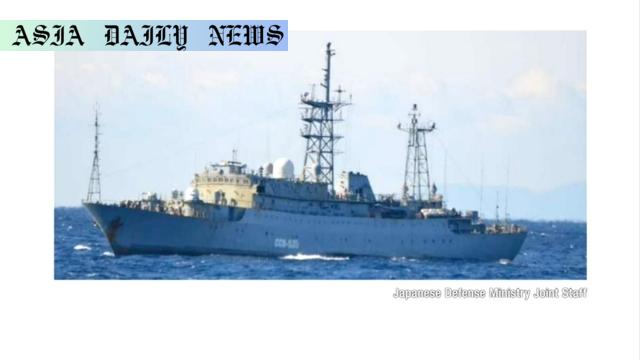Russian Navy observed moving through Japan’s contiguous zone for the first time near Miyazaki, highlighting geopolitical tensions.

Russian Naval Presence in Japan’s Contiguous Zone
The Japanese Ministry of Defense recently observed the Russian Navy’s Vishnya-class intelligence vessel navigating within Japan’s contiguous zone, a maritime area adjacent to its territorial waters. This development, which occurred near the southwestern prefectures of Miyazaki and Okinawa, is a first for this region, sparking concern among Japanese officials.
The Sighting and Its Significance
On February 1, Japan’s Maritime Self-Defense Force detected the Russian vessel approximately 50 kilometers southeast of Okinawa’s main island. The ship was heading southward at the time. Following its passage through Japan’s contiguous zone, it eventually moved toward the East China Sea on Sunday. This raises immediate questions about the intentions behind this maneuver, especially given Japan’s strategic location in the Pacific.
Historical Context and Recurring Presence
This is not the first time the same Russian naval vessel has been detected in Japanese waters. Last November, the ship was spotted in the Tsushima Strait, located between Japan’s Kyushu Island and mainland Asia. This recurring presence underscores a pattern of intelligence-gathering behavior by the Russian Navy around Japanese waters.
Geopolitical Implications
The strategic placement of Okinawa and Miyazaki makes these locations crucial for Japan’s maritime defense. The fact that a foreign intelligence vessel entered a zone so close to Japan’s territorial waters raises significant geopolitical concerns. The event also highlights the complexities of Japan’s relations with its neighbors, especially within a region fraught with territorial disputes and military competition.
Japan’s Response and Global Observations
Japanese defense officials have been closely monitoring the situation and will likely continue to enhance surveillance in the region. This incident may also prompt Japan to coordinate further with its allies, including the United States, to ensure the security of its territorial waters and contiguous zones. The presence of Russian naval assets near Japan emphasizes the volatile nature of the Asia-Pacific geopolitical environment.
Conclusion
The presence of the Russian Navy vessel in Japan’s contiguous zone near Miyazaki is an unprecedented event that has captured the attention of military and geopolitical analysts alike. As tensions rise in the Indo-Pacific, careful monitoring of such activities becomes increasingly crucial to maintain stability in the region. This incident could pave the way for stronger maritime policies and international collaboration to address shared security concerns.
Commentary
Geopolitical Tensions Escalate in the Asia-Pacific
The recent sighting of a Russian Navy vessel in Japan’s contiguous zone is a stark reminder of the increasingly intricate dynamics of international relations in the Asia-Pacific region. With rising geopolitical tensions among major powers, such incidents not only highlight the strategic importance of the region but also Japan’s pivotal role in maintaining stability and balance.
The Implications for Japan’s Defense
This development poses a significant challenge for Japan’s defense authorities, who need to balance vigilance with diplomacy. The proximity of the Russian vessel to Okinawa, a hub for U.S. military presence in the Pacific, adds another layer of complexity to the issue. Japan must remain steadfast in monitoring its waters while working closely with allies to ensure security and stability in the region.
Global Stakeholders and Their Roles
The incident also underscores the global dimension of regional security. The Asia-Pacific is a focal point of interest for many nations due to its economic and strategic significance. Incidents like these invite a broader dialogue among global stakeholders to address shared security concerns and to ensure the maritime laws of the region are upheld.


